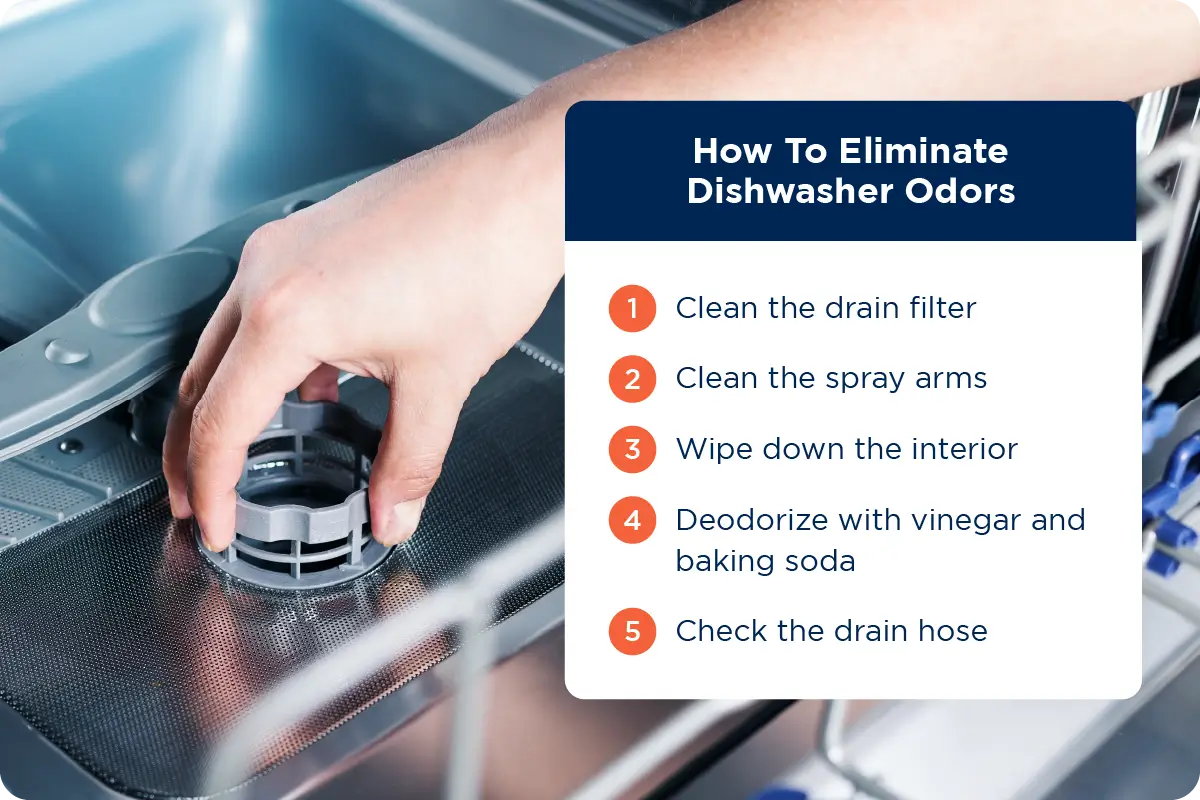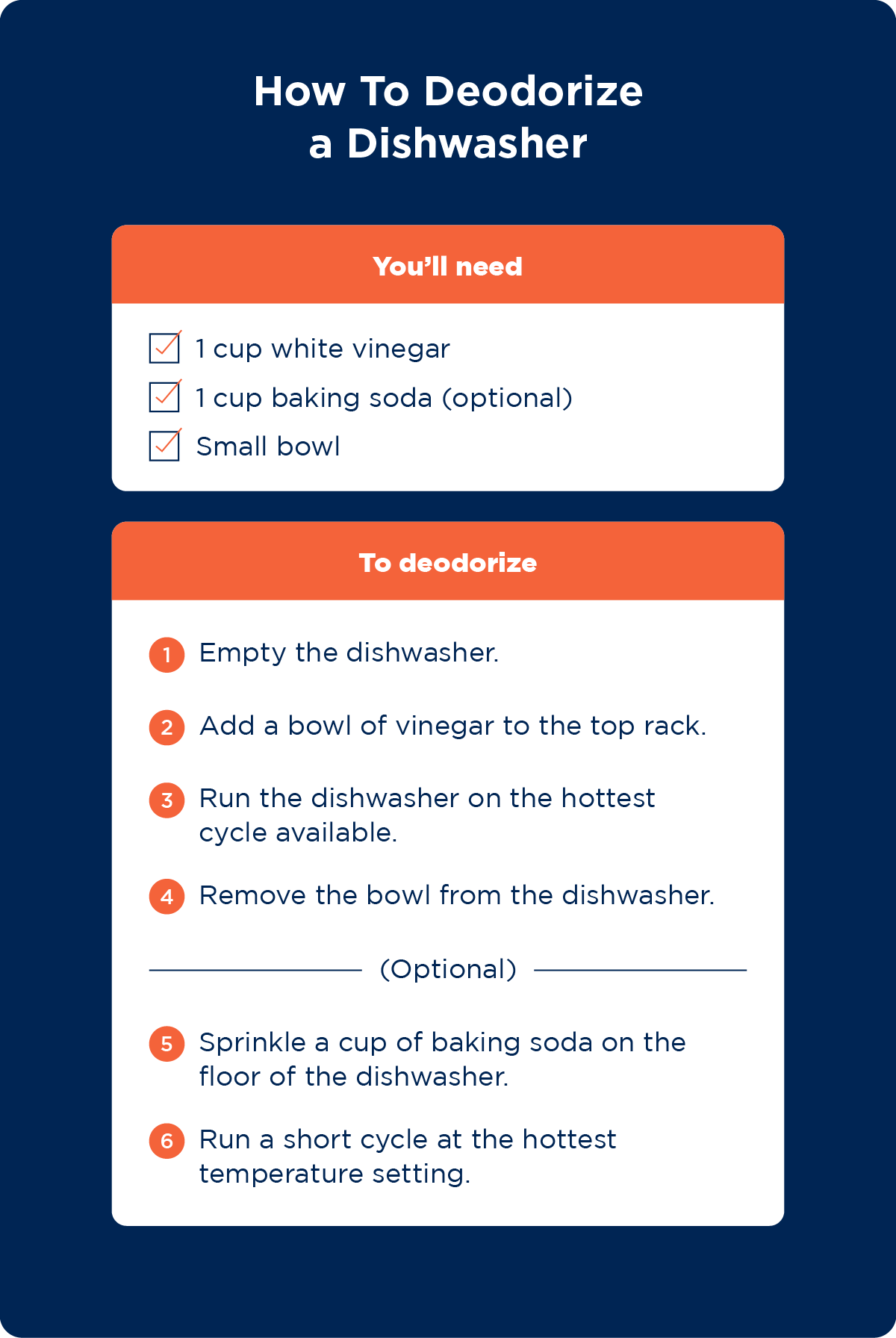Dishwasher Smells? Here’s How To Fix It [5 Easy Steps]

|
Dishwasher smells can be attributed to several causes, like a clogged drain hose, a dirty filter, or mold. Luckily, most odors can be eliminated with a few simple fixes, like cleaning the drain filter, wiping the inside of the dishwasher, and deodorizing with vinegar and baking soda. |
Dinner leftovers are put away, the counter is wiped, and dishes are clean. So where’s that odor coming from? If you’ve discovered your dishwasher smells bad, it means the appliance isn’t running as well as it should.
Twenty percent of Americans admit to never cleaning their dishwasher, likely due to the misconception that appliances that clean other things should also be able to clean themselves. But over time, food particles, grease, and soap scum can accumulate inside your dishwasher, resulting in unpleasant odors, clogs, bacterial growth, and reduced cleaning power.
Here’s how to clean a smelly dishwasher and restore its full functionality.

1. Clean the Drain Filter
The first step in cleaning a foul-smelling dishwasher involves addressing one of the most common sources of odor and blockage: the drain filter. Many dishwashers have a drain filter to prevent food particles from clogging the drain.
Follow these steps to clean it:
- Remove the drain filter from the floor of the dishwasher. The drain filter is usually located near the bottom of the dishwasher, beneath the spray arm. It's often a circular or mesh-like component that can be removed.
- Wash the filter in your kitchen sink with hot water and soap. Use a bottle brush or toothbrush to reach all the interior surfaces. Make sure to clean both sides of the filter.
- Check the drain itself for food debris and gunk. Wipe away any debris or buildup with a sponge.
- Reinsert the clean dishwasher drain filter. Once it’s securely inserted, you can return power to the appliance.
It’s good practice to clean your drain filter at least once a month. This routine dishwasher maintenance can help prevent buildup and blockages, keeping your dishwasher stink-free and running smoothly.
2. Clean the Spray Arms
Your dishwasher’s spray arms are responsible for distributing water and detergent to clean your dishes effectively. If a spray arm becomes clogged with food, the dishwasher’s ability to clean your dishes diminishes greatly. The debris also leads to unpleasant dishwasher smells.
Luckily, it’s somewhat easy to clean the spray arms:
- Remove the spray arms. Open the dishwasher and pull out the bottom rack to access the spray arms. Most dishwashers have an upper spray arm and a lower spray arm. Gently twist or unclip the spray arms to remove them from their mounting brackets. You may not be able to remove the upper spray arm in some dishwasher models.
- Rinse the spray arms. Hold the spray arms over the kitchen sink and rinse them thoroughly under warm running water. Use a soft brush, toothbrush, or cotton swab to remove mineral deposits or debris from the nozzles.
- Inspect and clean the mounting brackets. While the spray arms are removed, inspect the mounting brackets for clogs or buildup and clean them as needed.
- Check the upper spray arm for clogs. If the upper arm is not removable, use a soft, damp rag or sponge to wipe it down and check the nozzles for clogs and mineral buildup.
- Reassemble and test the spray arms. Once the spray arms are clean and the mounting brackets are clear, reattach the spray arms to their original positions. Ensure they are securely in place, then run a short test cycle to verify that water is flowing through them evenly.
Make a habit of cleaning your spray arms every two to three months as part of your routine dishwasher maintenance. You may need to clean them more often if you use your dishwasher frequently or often wash dishes with significant food residue.
3. Wipe Down the Inside of the Dishwasher
Over time, grime can accumulate on the interior walls, racks, and seals of the appliance. A quick wipe-down can do wonders for removing that foul dishwasher odor.
Here’s how to clean a smelly dishwasher interior:
- Remove the dish racks. Start by removing both the bottom and top dish racks to gain better access to the dishwasher's interior. Run them under hot water in the kitchen sink.
- Wipe down the interior. Use a soft cloth or sponge dampened with a mixture of warm water and mild dish soap to wipe down the interior surfaces of the dishwasher. Pay special attention to the door, walls, and the area around the door seals. This is where food residue, grease, and soap scum tend to accumulate.
- Remove stubborn gunk. If there’s stuck-on debris, use white vinegar and a sponge to remove it.
- Clean the seals. Gently clean the door gasket (seal) with a cloth or sponge, making sure to remove any debris or residue trapped in the crevices.
- Rinse and dry. After cleaning, rinse the interior with clean water to remove any soap residue. Dry the dishwasher's interior with a clean, dry cloth.
- Reassemble the dishwasher. Put the dish racks back in their respective positions, ensuring they are securely in place.
For routine maintenance, you should wipe down the inside of your dishwasher every two to three weeks to prevent soap and gunk buildup. If you notice visible residue or unpleasant odors coming from your dishwasher, clean the interior immediately.
4. Deodorize the Dishwasher With Baking Soda or Vinegar
White vinegar is a potent odor-fighting agent, yet it’s completely natural and safe to use.
Here’s how to deodorize your dishwasher with vinegar:
- Empty the appliance of all dishes.
- Add vinegar to the top rack. Place one cup of white vinegar in a stable bowl on the top rack of the dishwasher.
- Run the dishwasher on the hottest cycle available. The acids in the vinegar will break down deposits on the interior of the appliance and leave it smelling fresh.
- Remove the bowl from the dishwasher. For even more odor-busting power, follow up with the steps below.
Baking soda is also excellent for neutralizing smells without using harsh chemical cleaners. If you prefer to deodorize your dishwasher without vinegar, you can use baking soda as an alternative:
- Sprinkle a cup of baking soda on the floor of the dishwasher.
- Run a short cycle at the hottest temperature setting. Ensure all the baking soda dissolves. This should eliminate any remaining dishwasher odor.

5. Check the Drain Hose
If the dishwasher odor lingers or returns quickly after you follow all these steps, something could be wrong with the drain hose. Another potential sign of this is standing water at the bottom of the dishwasher after a wash cycle.
A little troubleshooting should help you determine a remedy:
- Examine the hose. Look under the sink at the corrugated hose coming from the dishwasher to the sink drain pipe or garbage disposal.
- Make sure the hose isn’t bent or restricted. This can limit the flow and lead to standing water in the dishwasher. If the hose is damaged, it’s time to schedule a dishwasher repair.
- Raise the hose if needed. If wastewater from the kitchen sink appears to be backing up into the dishwasher, prevent this by raising the drain hose loop a little higher. If it fails to stay in place, secure it to the wall with a hose bracket.
Reasons Why Your Dishwasher Smells So Bad
If your dishwasher is emitting a not-so-pleasant aroma, the culprit might just be a buildup of leftover food, grease, and soap scum hanging out in the nooks and crannies of your appliance. However, choosing to ignore the stench could lead to much more serious issues. Here are a few of the most common sources of dishwasher odors.
1. Clogged Drain Hose
The accumulation of food waste, grease, and soap scum is a common cause of clogs in a dishwasher's drain hose. Over time, these materials can obstruct the smooth flow of water, leading to drainage issues.
Foreign objects such as broken glass can also contribute to blockages. In areas with hard water, mineral deposits further exacerbate the problem by leaving stubborn residues that impede water movement. Installing a water softener is a proactive solution.
If your dishwasher smells like sewage, it could be a sign of a clogged hose. Other indicators include:
- Standing water in the bottom of the dishwasher
- Gurgling sounds
- Leaks around the dishwasher
- Visible debris in the drain hose
While the good news is that repairing a clogged drain hose is a fairly straightforward process, it should be handled by a professional like your local Mr Appliance.
2. Dirty Filter
Dishwasher filters play a crucial role in trapping food particles and debris during the cleaning process, preventing them from recirculating onto your dishes. However, these filters can become dirty and clogged over time, compromising efficiency.
Food remnants can accumulate in the filter's mesh or screen, while grease may adhere to the filter surfaces. In hard water areas, mineral deposits can further contribute to filter clogging, reducing the dishwasher's overall performance.
3. Mold Growth
Mold can grow in a dishwasher due to the warm and humid environment created during the washing and drying cycles, providing an ideal breeding ground for mold spores.
The presence of organic material, such as leftover food particles, in the dishwasher further contributes to mold development. Mold can grow on various surfaces, including the door gasket, spray arms, and in hidden corners of the appliance.
To determine if mold is growing in your dishwasher, watch out for telltale signs, like:
- A musty or unpleasant odor
- Black or greenish spots on the interior surfaces
- Discoloration of interior surfaces
- Residue or film on dishes after cleaning
- Allergic reactions like sneezing or coughing when near the dishwasher
Regularly cleaning and maintaining your dishwasher, including wiping down seals and interior surfaces, can help prevent mold growth and ensure a safe kitchen environment.
4. Melted Plastic
If your dishwasher smells like burning plastic, it very well could be burnt plastic. Many plastic materials are not heat-resistant and can warp under the extreme conditions of a dishwasher. Failure to adhere to the manufacturer's guidelines, which often recommend hand washing or using the dishwasher's top rack for plastic items, can result in unintended damage.
The combination of hot water, steam, and elevated drying temperatures can cause plastic items to soften and lose their original shape. This is particularly true for plastic containers, water bottles, or other items not labeled as dishwasher-safe.
To prolong the life of your plastic items, it's crucial to check their compatibility with dishwashers, adhere to recommended washing instructions, and use the dishwasher's designated compartments for plasticware. When in doubt, handwashing or opting for dishwasher-safe plastics is a safer choice to prevent unintentional damage.
5. Overdue for Maintenance
Servicing your dishwasher at least once a year can prevent unpleasant smells altogether and prolong the life of your dishwasher.
During routine maintenance, a Service Professional can inspect key components such as the:
- Drain filter
- Spray arms
- Interior surfaces where food particles and debris may accumulate
They can also check and address any issues with the dishwasher's gaskets and drainage system, preventing leaks and water buildup that may contribute to odors.
By addressing these areas, servicing helps prevent the growth of odor-causing bacteria and ensures optimal water drainage, reducing the risk of stagnant water and foul smells. This approach not only enhances the longevity and efficiency of the appliance but also ensures that you can enjoy clean and odor-free dishes after every wash cycle.
How To Prevent Dishwasher Odors
You can’t expect clean, sanitized dishes from a funky-smelling dishwasher. Follow these practical tips to help prevent unpleasant odors and keep your dishwasher in top condition.
- Use a proper loading technique. Ensure you load your dishwasher according to the manufacturer's guidelines, allowing water and detergent to reach all surfaces. Avoid overcrowding and blocking spray arms to promote effective cleaning.
- Regularly clean the interior. Wipe down the interior of the dishwasher, including seals, gaskets, and the door, to remove accumulated debris and prevent the growth of bacteria. Pay special attention to hidden corners and the drain filter.
- Scrape your dishes. Scrape off excess food from dishes before loading them into the dishwasher.
- Use the right detergent. Choose a high-quality dishwasher detergent suitable for your water hardness and dishwasher model. Using the correct amount of detergent helps prevent soap scum and residue build-up.
- Run hot water before starting a cycle. To ensure the dishwasher starts with hot water, run the kitchen sink's hot water faucet until it reaches its highest temperature before starting a wash cycle.
- Schedule annual servicing: Consider scheduling professional servicing for your dishwasher at least once a year — if you use your dishwasher frequently or live in an area with hard water, you might benefit from more frequent servicing. This preventative maintenance can help address potential issues, clean crucial components, and ensure your dishwasher operates efficiently.
FAQ About Dishwasher Smells
From understanding the reasons behind dishwasher smells to effective deodorizing techniques and prevention tips, we've compiled some of the most frequently asked questions to help you troubleshoot and eliminate odors in your dishwasher.
How Do I Get Rid of a Bad Smell in My Dishwasher?
To get rid of a bad smell in your dishwasher, start by cleaning the drain filter, wiping down the interior surfaces, and inspecting the spray arms for any debris. Run a cycle with white vinegar or baking soda to neutralize odors and disinfect your dishwasher.
Why Does My Dishwasher Smell So Bad?
A foul-smelling dishwasher is often due to the accumulation of food debris, grease, and soap scum in various components, like the drain filter, spray arms, and seals. Bacteria can thrive in these moist, organic-rich environments, leading to unpleasant odors.
How Do I Deodorize My Dishwasher With Vinegar and Baking Soda?
To deodorize your dishwasher with vinegar, place a cup of white vinegar in a dishwasher-safe container on the top rack and run a hot water cycle. The vinegar helps eliminate odors and disinfect the interior. For an extra boost, sprinkle baking soda on the bottom of the dishwasher before running another short cycle.
Can Mr. Appliance Help with a Stinky Dishwasher?
If you’ve followed all the steps and tips listed in our guide and are still struggling with a smelly dishwasher, you may need to contact a repair expert. Reach out to your local Mr. Appliance for swift dishwasher repair services and maintenance so you can get back to enjoying the heart of your home.
 Click to call
Click to call


